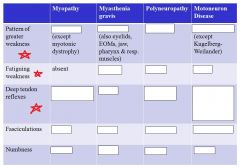![]()
![]()
![]()
Use LEFT and RIGHT arrow keys to navigate between flashcards;
Use UP and DOWN arrow keys to flip the card;
H to show hint;
A reads text to speech;
19 Cards in this Set
- Front
- Back
|
Clumsiness in greater proportion than loss of power
Babinski sign present (immediate) Spasticity (delayed) Increased tendon reflexes (delayed) Little if any atrophy what type of lesion? (o) |
Upper motor neuron lesion
|
|
|
what is Spasticity...what is it associated with (upper or lower mn)
(o) |
A unidirectional increase in muscular tone
Involves increased tone in “anti-gravity” muscles In the upper extremities, resistance to stretching out biceps, but not triceps In the lower extremities, resistance to stretching out quadriceps but not hamstrings seen in upper motor neuron |
|
|
What is Rigidity? what is it seen in?
(o) |
Seen in Parkinson’s disease and other extrapyramidal disorders
A bi-directional increase in tone to passive range of motion The resistance to passive range of motion is relatively independent of degree of force or rate of speed |
|
|
What is Paratonia? commonly seen in?
(o) |
feels like the pt is trying to stop you from moving the limb
Commonly seen in dementia Also known as gegenhalten (to hold against) A bidirectional resistance to passive range of motion that increases with force and rate of movement, as if voluntary |
|
|
Loss of power in greater proportion than clumsiness
Hypotonia Muscle atrophy Muscle fasciculations what type of lesion? (o) |
Lower Motoneuron
|
|
|
Compare Duchenne, Facioscapulohumeral, and Limb girdle Muscular dystrophies for the following characteristics:
Age of onset Sex Pseudohypertorphy Initial distribution Involvement of the face Rate of progression Contractures and deformity Inheritance (o) |

|
|
|
what is the genetic defect in duchenne muscular dystrophy?
|
Dystrophin gene on short arm of X chromosome codes for dystrophin protein, which is a cytoskeletal structural protein.
this is damaged |
|
|
a boy presents to your office and on physical exam you note that their calves are pretty toned. Mom says that when the boy is on the ground he does this strange thing where he arches his back and climbs his way off the ground...what is this called? sign of?
|
Gower's sign
in Duchenne |
|
|
you are in your neuro office and examining a young lady patient who has issues with smiling. You ask her to smile and she physically can't. Her forehead is unwrinkeld and the corners of her mouth do not curl. On physical exam, you note winging of the scapula. What does this pt have?
|
Facioscapulohumeral Muscular Dystrophy
One key gene is on the long arm of chromosome 4. The function of the gene product is as yet unknown. |
|
|
a man presents to you with a seemingly triangular face. On a hunch, you hit their hypothenar eminence with your reflex hammer and it causes their thumb to move towards their pinky. To confirm what you think, you have the pt squeeze your hand and tell them to open it as soon as you tell them. When you say go, their hand stays in a grip...what do they have? What is the genetics going on?
|
Myotonic Dystrophy
A gene near the centromere of chromosome 19 codes for myotonic dystrophy protein kinase. In M.D. dozens to hundreds of “CTG” repeats occur in the gene. The transcribed mRNA gets trapped within the cell’s nucleus. |
|
|
what happens in Myasthenia gravis physiologically?
(o) |
antibodies to the AChR
|
|
|
pt presents to your office with muscle weakness. They say they are fine in the morning, but by the end of the day they have drooping eyelids, jaw drop, and drooling...what do they likely have?
|
MG
|
|
|
what are some of the associated dz with MG? what is the most important one?
|
THYMOMA (malignant mediastinal tumor)
thyroid disease widespread immune complex disease |
|
|
what is a polyneuropathy
(o) |
Bilaterally symmetric
Distinct from mononeuropathy and multiple mononeuropathies so the key is that you have to have the deficit on the same spot on both sides mulitple mononeuorpathies would be like radial on one side, ulnar on the other poly is like whole left and right hand (stocking and glove is a common characteristic of polyneuopathy) |
|
|
Distal-greater-than-proximal weakness
Distal-greater-than-proximal numbness A “stocking-glove” pattern of weakness, numbness or both “Length-dependent” neuropathy Disrupts DTRs more than other forms of lower-motoneuron weakness this describes? (o) |
Polyneuropathy
the longer the axon the worse it is affected |
|
|
Werdnig-Hoffman is a motoneuron disease affecting what population?
* |
NEONATES
you will see characteristic FROG LEG position and floppy baby (other thing that causes floppy baby? Botulin toxin) BABIES WILL NOT HAVE REFLEXES |
|
|
a 60 year old man presents to your office and says that he cannot do routine tasks such as going up steps, getting out of a chair, or swallowing. You note widespread atrophy. What do you suspect...
|
Amyotrophic Lateral Sclerosis
ALS |
|

|

|
|
|
of the following, which will have a MARKEDLY increase CK level?
Myopathy MG Polyneuropathy Motorneuron disease |
Myopathy
(think duchenne's muscular dystrophy) |

